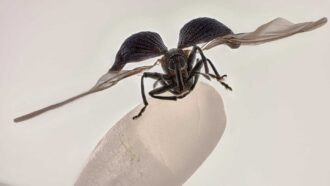Walktopus
Some octopuses can walk, using two of their eight arms to scoot backward.
Share this:
- Share via email (Opens in new window) Email
- Click to share on Facebook (Opens in new window) Facebook
- Click to share on X (Opens in new window) X
- Click to share on Pinterest (Opens in new window) Pinterest
- Click to share on Reddit (Opens in new window) Reddit
- Share to Google Classroom (Opens in new window) Google Classroom
- Click to print (Opens in new window) Print
By Emily Sohn
Crissy Huffard spends so much time studying octopuses that they’ve been known to take over her life.
“There were times when I’d close my eyes and see octopuses because I’d been watching them so many hours a day,” Huffard says. She’s a graduate student at the University of California, Berkeley.
“I’d have dreams that I’d find land octopuses,” she says. Then she wouldn’t have to be in the water all the time, using scuba and snorkeling gear to study them.
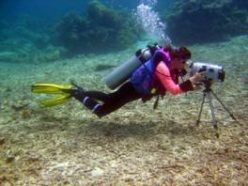 |
|
Crissy Huffard uses scuba gear and a video camera to study octopuses. |
| Courtesy of Crissy Huffard |
Huffard hasn’t come across any land octopuses yet, but she has made another important discovery. In Indonesia and Australia, she has found two species of octopus that actually walk on two arms.
It’s the first time anything like walking has ever been seen in an animal with no bones. Understanding how octopuses do it might eventually help engineers design “soft” robots that can move in a similar way.
The discovery, Huffard says, also emphasizes just how much there is left to learn about these squishy, eight-armed creatures.
“We’re just now piecing together a lot of aspects of [octopus] behavior,” Huffard says. Although people have been observing octopuses for hundreds of years, “only recently have we had the technology to take video cameras underwater to spend long periods of time with them.”
Jet propulsion
Octopuses normally move around in one of two ways. Sometimes, they funnel water through their bodies, then squirt the water out to propel themselves. They can also crawl on the seafloor by pushing and pulling with suckers on their arms. They have flexible muscles filled with fluid to help them move around.
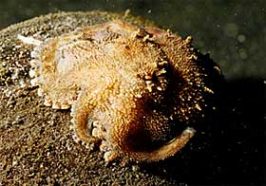 |
|
A small Octopus marginatus sitting on a coconut shell. |
| Image courtesy of Roy Caldwell, UC Berkeley |
Huffard first noticed a walking octopus one day in 2000, while scuba diving in Indonesia. She had spent an entire day following a type of octopus called Octopus marginatus. About the size of a small apple, it’s also known as the coconut octopus.
She was observing its behavior and trying to learn more about its day-to-day life. Oceanographers, meanwhile, filmed the animal.
“At one point, we got close to it with the camera,” Huffard says, “and it just lifted its arms up and started walking. And I thought, ‘That’s really strange.'”
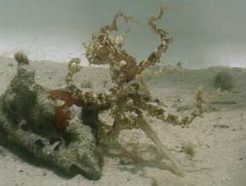 |
|
Octopus aculeatus walking over rugged terrain. |
| C. Huffard, UC Berkeley |
A few years later, she observed the same behavior in another species, Octopus aculeatus, while snorkeling off Lizard Island in Australia. Also known as the algae octopus, its body is about the size of a walnut. Huffard then collected more video footage.
Conveyor belts
When she looked at the tapes, Huffard was able to see exactly what was happening. “Immediately, we knew this was different from all other types of octopus locomotion,” she says.
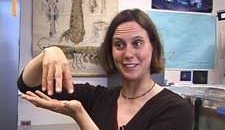 |
|
Huffard demonstrating how an octopus can propel itself. |
| Emily Sohn |
Typically, such an octopus moves by drawing six arms around its body and using its backmost pair of arms for propulsion. The two arms take turns bending forward and rolling on the bottom of the ocean, like little conveyor belts, to push the octopus backwards.
Interestingly, researchers in Italy had previously found that they could produce a similar motion in octopus arms that had been cut off. All they had to do was to stimulate an arm with an electrical pulse or bump it. The motion was exactly the same every time.
Based on that work, Huffard and her colleagues suggest that octopuses don’t need to use their brains to walk. Such walking might be just an automatic, or instinctive, behavior.
Masters of disguise
Octopuses are famous as masters of disguise. They can change color rapidly to blend in with their environments. They have muscles under their skin that can make them look spiny or smooth, depending on whether they want to resemble rocks or sand. They can also change their body shapes and squeeze in and out of small holes and other hard-to-reach places.
Walking on two arms appears to be another form of camouflage, Huffard proposes. It’s perfect for when the animals want to move but don’t want to be seen.
O. aculeatus look like blobs of tiptoeing algae when they move quickly. O. marginatus, which live near areas where coconut trees are common, look like fallen coconuts rolling with the current.
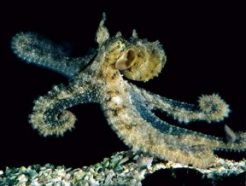 |
|
Flashy projections on the skin of Octopus aculeatus allow the animal to camouflage itself so that it looks like a blob of algae. |
| Image courtesy of Roy Caldwell, UC Berkeley |
Walking has long been thought to require the combination of muscle pushing against bone. Walking octopuses prove that bones aren’t necessary.
Like walking octopuses, robots of the future may be able to squeeze themselves in and out of small spaces while remaining strong enough to support themselves. Soft robots could be useful in rescue missions and other situations.
A wet life
Huffard, meanwhile, continues to dream about what else her career as an octopus researcher might have in store. She has even grown used to the lifestyle required by the work.
As an octopus researcher, “you spend a lot of time in the water,” she says. “Life proceeds with pruny fingers.”
Huffard adds, “You spend a lot of time away from home and away from pizza and movies and the normal creature comforts that we think of.”
All that sacrifice, though, is worth it, she says, because there’s still so much left to learn about octopuses and the world they live in.
“It’s great because you see something new and different every day,” Huffard says. “And that really motivates me to spend more time in the water trying to understand our marine environment.”
Going Deeper:


